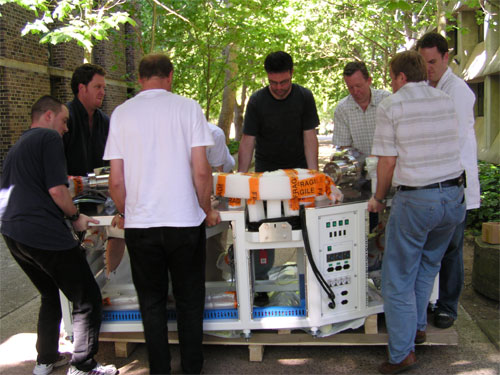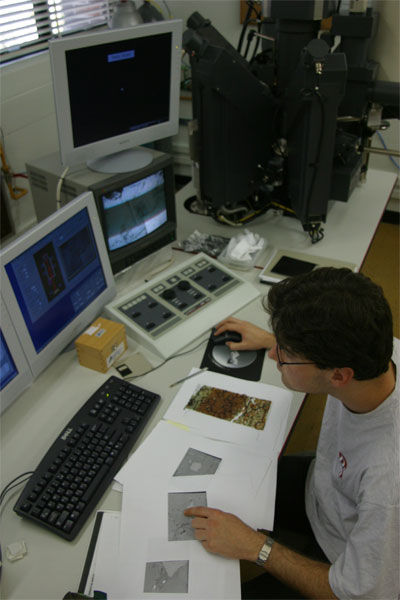Technology development program
BackgroundGEMOC’s research, training and Industry Interaction programs require a high level of geochemical analytical technology, which is provided by the state-of-the-art facilities available to the Key Centre. Continual development of both technology and innovative analytical and microanalytical approaches is required to meet our research aims and the needs of our industry collaborators. GEMOC develops new analytical strategies as required, to determine the chemical and isotopic composition of geological materials (both solid and fluid) in solution and in situ. Special emphasis is being placed on the development of advanced in situ microbeam methods. These developments are transmitted to industry via open and collaborative research, through technology exchange visits and workshops, and as an integral part of the training program. |
||||
|
THE ANALYTICAL INSTRUMENTATION and support facilities of the Macquarie University Geochemical Analysis Unit (GAU) represent a state-of-the-art geochemical facility. In 2004 this will be enhanced by the relocation of the stable-isotope operations of the former Centre for Isotope Studies, previously housed at CSIRO, North Ryde, to GEMOC.
“Continual development of both technology and innovative analytical and microanalytical approaches is required to meet the research aims and the needs of our industry collaborators.” |
||||
|
Everyone pitching in to help move the Nu MC-ICPMS. |
||||
The GEMOC Facility for Integrated Microanalysis (FIM) and Micro GIS developmentGEMOC is continuing to develop a unique, world-class geochemical facility, based on in situ imaging and microanalysis of trace elements and isotopic ratios in minerals, rocks and fluids. The Facility for Integrated Microanalysis now consists of four different types of analytical instrument, linked by a single sample positioning and referencing system to combine spot analysis with images of spatial variations in composition (“micro-GIS”). All instruments in the FIM have been operating since mid-1999. Major instruments are being replaced or upgraded in 2002-2004 through the $5.125 million DEST Infrastructure grant awarded to Macquarie University with the Universities of Newcastle, Sydney, Western Sydney and Wollongong as partners. the facility provides:
Electron Microprobe: for imaging and point analysis of major and minor elements Scanning Nuclear Microprobe: for imaging and point analysis of trace elements at ppm levels Laser-ablation ICPMS Microprobes: for point analysis of a wide range of trace elements at low ppb levels Multi-collector Sector ICPMS with laser microprobe: for high-precision in situ analysis of isotopic ratios Micro-GIS system: A key aspect of the Facility is the co-registration of images and point analyses collected on all instruments. All data for a sample, from any of the instruments or from a bench microscope, are in the same coordinate system and can be overlaid in the computer to enhance interpretation. When fully developed, images from one instrument will be read into the computer of another instrument and used to guide the analysis. Major-element maps from EMP, or trace-element maps from the nuclear microprobe, can be linked directly to images from petrographic or cathodoluminescence microscopes, BSE or SEM, or to spot analyses. |
||||
|
Mathieu Choukroun (MSc intern from Ecole normale Superieure, Paris) using the new Cameca SX-100 electron microprobe. |
||||
current statusElectron microprobe (EMP): The original GEMOC EMP is a CAMECA SX50, installed in 1993; it routinely produced high-precision analyses of major and minor elements with a spatial resolution of one micron, as well as high-quality images of major-element (> 0.1 wt%) distribution over areas up to 45 x 45 mm, by stage-scanning with five fixed wavelength-dispersive spectrometers. In early 1999 the EMP was upgraded with an energy-dispersive X-ray detector to allow rapid and simultaneous mapping of all major elements. In early 2003 a new CAMECA SX100, with a similar configuration of spectrometers, was installed and the SX50 is now used almost entirely for the imaging and analysis of zircons, in connection with TerraneChronTM applications and basic research. Scanning nuclear microprobe (SNMP): This instrument was built by Dr C. G. Ryan (with GEMOC funding contribution) as a separate beam line on the HIAF particle accelerator at CSIRO, North Ryde. The design incorporates several complementary types of detector, a new high-resolution probe-forming system and an innovative optical system, and provides both images of trace-element distribution and spot analyses, with a lateral resolution of 1-3 µm. Current capabilities cover micro-PIXE, micro-PIGE and quantitative element imaging. Due to the closure of CSIRO’s North Ryde site during 2004, the SNMP beam line will be relocated to the accelerator facility at the University of Melbourne. Laser Ablation ICPMS microprobe (LAM-ICPMS): The original GEMOC LAM was installed in December 1994 using a Perkin-Elmer ELAN 5100 ICPMS (later replaced by an ELAN 6000), attached to a UV laser ablation microprobe built for GEMOC by Memorial University, Newfoundland. In 1999 the ICPMS was replaced by a Hewlett Packard 4500, and in 2000 an Agilent 7500 ICPMS was added. These two instruments now routinely provide quantitative analyses of > 30 elements at sub-ppm levels in minerals, glasses and metals, as well as precise U-Pb dating of zircons. The laboratory currently uses three Nd:YAG LAM systems: a Quantel Brilliant laser that can deliver beams of either 266nm or 213nm light, a Merchantek LUV 266nm system, and a Merchantek/New Wave LUV213 nm system. Spatial resolution varies with the application, but typically is on the order of 30-40 µm. The LAM is fitted with a computer-driven sample stage to provide co-registration of X-Y coordinates with the other instruments. On-line data reduction with the GEMOC-developed “GLITTER” software enhances laboratory productivity and data interpretation; the software is marketed internationally by New Wave Research. Multi-collector LAM-ICPMS microprobe (MC-LAM-ICPMS): A fully-equiped Nu Plasma MC-ICPMS is an integral part of the Facility. This instrument combines a laser ablation microsampler, an Ar-plasma ionisation source, and a multi-collector magnetic-sector mass spectrometer, to provide high-precision in situ analysis of isotope ratios in geological materials. The current laser is a New Wave 193nm system based on an Lambda Physik OPTex excimer laser. The MC-ICPMS also can be used in solution mode, with either a standard nebuliser or a desolvating nebuliser, to provide high-precision isotopic analysis of a wide range of elements, including many not accessible by standard thermal ionisation mass spectrometry. A second Nu Plasma instrument, with high-resolution capabilities and a retardation filter to enable U-series work, was installed late in 2003. |
||||
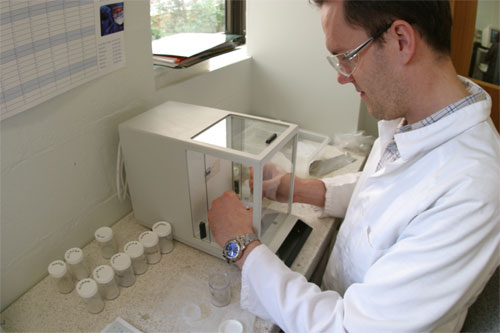
Peter Wieland preparing samples for isotopic analysis. |
||||
|
Applications in use and under development include: Laser Analysis (in situ point analysis)
Solution Analysis
|
||||
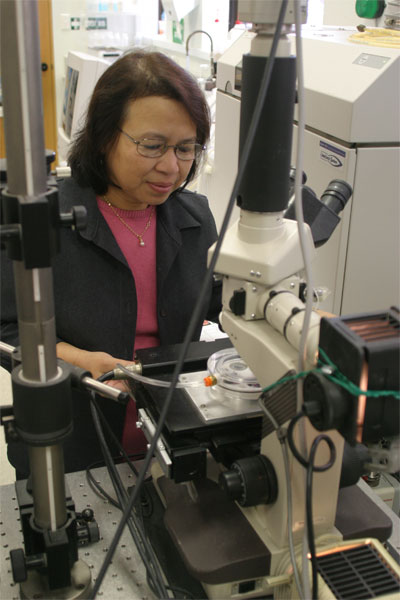
Tin Tin Win from CSIRO using the LAM-ICPMS for zircon dating. |
||||
progress in 20031. Facility for Integrated Microanalysis a. Electron Microprobe: A fully optioned Cameca SX-100 electron microprobe with five crystal spectrometers and an energy-dispersive spectrometer, to replace GEMOC’s aging but still highly functional SX-50 instrument, arrived in late December 2002, and was installed in January 2003. The energy-dispersive spectrometer has been returned for repairs, but the instrument is otherwise performing well. b. Laser-ablation ICPMS microprobe (LAM): During 2003, the LAM laboratory produced large volumes of data for eight Macquarie PhD thesis projects, several projects carried out by international visitors and Honours students, in-house funded research projects and industry collaboration. These projects included the analysis of trace elements in the minerals of mantle-derived rocks, in sulfide minerals and in a range of unusual matrices. Over 5000 U-Pb analyses of zircons were carried out, related to projects (including TerraneChronTM applications) in South America, Scandinavia, Mongolia, Turkey, China and Australia. The LAM laboratory also routinely provides data for projects related to mineral exploration (diamonds, base metals, Au), as a value-added service to the industry. New developments included further improvements in the quantitative in situ analysis of diamonds, as part of Sonal Rege’s PhD project, supported by DeBeers, on the trace-element signatures of diamonds (see Research Highlights). The 4500 instrument is now dedicated primarily to U-Pb dating of zircons, where its stability and ease of operation provide a high throughput. c. MC-ICPMS: A multi-collector magnetic sector ICPMS for in situ (laser-ablation) and solution analysis of isotopic ratios was installed in November 1998. The instrument is the Nu Plasma, designed and manufactured by Nu Instruments of Wrexham, UK. The instrument was producing good data only a few days after installation, and has continued to do so. Merchantek EO (now New Wave Research) has provided a 266 nm UV laser microprobe (under a collaborative agreement; see below) for use with the MC-ICPMS and a 213 nm laser microprobe was purchased in 2000. During 2002 the MC-ICPMS was fitted with a New Wave/Merchantek excimer (193 nm) laser microprobe, based on a Lamba Physik OPTex laser. This has been used mainly for the analyis of Hf isotopes in zircon, where its different absorption characteristics have provided somewhat greater spatial resolution and beam intensity than were available using the 213 nm laser. Major applications during 2003 (see Research Highlights) included the high-precision analysis of Hf in zircons to trace lithosphere evolution and magma-mixing histories in granitic rocks, the analysis of copper and iron isotope compositions in minerals from ore bodies, the analysis of Sr isotopes in clinopyroxene phenocrysts from lavas, and Re-Os dating of single grains of Fe-Ni sulfides in mantle-derived rocks. We carried out Re-Os studies on alpine-type peridotites from the Norwegian and Swedish Caledonides and xenoliths from the Kerguelen oceanic plateau, S. Africa, eastern China and Taiwan. A study of U-Pb and Hf-isotope systematics of zircons in late-Proterozoic sediments in southern Norway, continued from 2002, is providing a new view of the tectonics of southern Scandinavia. Further developments were made in 2003 for the in-situ analysis of Mg isotope compositions in mantle olivine and other phases in mantle peridotites. This involved the characterisation of potential standard materials and the investigation of the matrix effects on isotopic fractionation. Detailed studies were undertaken on olivine, pyroxene and amphibole in spinel peridotites from the Massif Central (France) and from Western Victoria (Australia), with the results providing further evidence of significant Mg isotopic fractionation in metasomatised samples. The rapid growth in the use of the TerraneChronTM application (see Research Highlights), coupled with the demand for in situ Re-Os analysis and stable isotope analysis, has led to severe competition for instrument time on the MC-ICPMS. An order was placed early in 2003 for a second instrument, funded by the DEST infrastructure grant, and this instrument was installed late in 2003. d. Scanning Nuclear Microprobe: The pending closure of the CSIRO North Ryde site forced the shutdown of the SNMP in late 2003. While the removal of the accelerator to the Clayton (Melbourne) site has been discussed, little progress has been made. The beam line has been dismantled, and will be re-installed on the University of Melbourne accelerator during 2004. It is anticipated that it will be able to operate for 2-3 days/week, and negotiations regarding access for GEMOC projects will take place once the SNMP is operative again. e. Laboratory development: Funding from the DEST infrastructure grant contributed toward the building of a new suite of clean-room laboratories on the second floor of building E5B, which include facilities for the work on U-series chemistry to be carried out by Dr Simon Turner and his group starting in 2003. Construction began in September 2003, and the facilities are scheduled for completion by the end of March 2004. f. Software: Chris Ryan further refined the GLITTER (GEMOC Laser ICPMS Total Trace Element Reduction) software, our on-line interactive program featuring linked graphics and analysis tables. This package provides the first real-time interactive data reduction for LAM-ICPMS analysis, allowing inspection and evaluation of each result before the next analysis spot is chosen. Its capabilities include the on-line reduction of U-Pb data. The use of GLITTER has greatly increased both the flexibility of analysis, and the productivity of the laboratory. New Wave Research now market the software together with their laser microprobe equipment; GEMOC provides customer service and backup through Macquarie Research Limited. Eleven copies of GLITTER were sold worldwide in 2003, and the software appears to have achieved industry-standard status; more than 30 copies are in use worldwide, in forensics and materials science, as well as earth science applications. |
||||
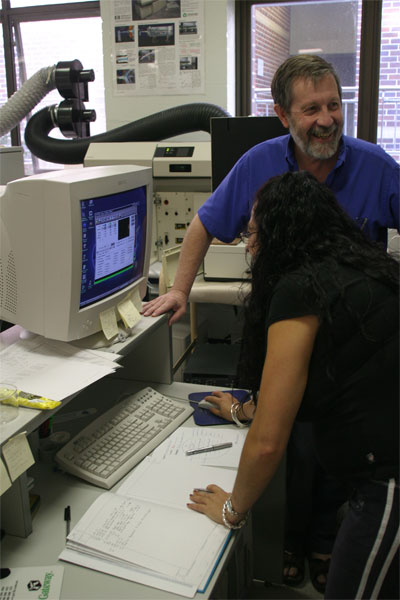
Bill Griffin and Suzy Elhlou |
||||
|
2. Laser development GEMOC continues to benefit from an industry partnership with New Wave Research (formerly Merchantek EO), a major US manufacturer of laser ablation systems, which has made Macquarie its Alpha Test Site. New Wave donated their 266 nm Nd:YAG UV laser ablation sampling system to GEMOC and their new 213 nm system was delivered early in 2000. Both lasers can be coupled to the Nu Plasma MC-ICPMS, allowing high precision isotope ratio determinations to be performed on minerals in situ. The mobility of the probes has allowed them to be used on the quadrupole ICPMS instruments as well, in a range of applications. A Merchantek/New Wave Research 193 nm excimer system based on a Lambda Physik OPTex laser was delivered in March 2002 and was finally commissioned late in the year. The 213 nm laser is now used for most of the U-Pb work, especially where small grains are being analysed, while the excimer system is used mainly for Hf-isotope analysis. A major upgrading of the laser park will take place in 2004, with the purchase of three new systems. 3. Energy Dispersive XRF A Spectro XLAB2000 energy-dispersive X-ray spectrometer was installed in November 2000 in a joint venture with Tasman Resources. This instrument utilises the polarisation of scattered X-rays to substantially reduce backgrounds and enhance detection limits. The XLAB2000 uses a specially designed 300 W palladium X-ray tube that improves its performance for the lighter trace elements, and also for major elements, relative to the earlier instrument. In addition, this spectrometer is fitted with a silicon detector, of a type recently developed, that eliminates the low-energy “tail” from the lightest elements, and enables all major elements to be measured in a fused glass to levels below 0.01%. The capability of the instrument to provide major element analyses of a quality at least comparable to the more expensive conventional crystal spectrometers has been thoroughly evaluated and confirmed. This instrument provides highest-quality data for major elements and for most trace elements to sub-ppm levels. The operation of the equipment is enhanced by a 100 position sample loader, one of the first to be installed on a Spectro instrument, and the purchase of a rocker furnace for sample preparation. During 2003 over 5000 samples were analysed for major and trace elements, providing data to student theses, in-house research projects, and industry collaborators. 4. Solution analysis The Agilent 7500 ICPMS is regularly used to provide trace-element analyses of dissolved rock samples for the projects of GEMOC researchers and students, and external users, supplementing the data from the XRF. The in situ analysis of the Rb-Sr, Lu-Hf, Sm-Nd and Re-Os systems by laser ablation microprobe has required the development of corrections for isobaric overlaps (eg 87Rb on 87Sr), and has demonstrated that these corrections can be done with very high precision in the Nu Plasma MC-ICPMS. This has allowed us to simplify the ion-exchange chemistry traditionally used to obtain clean element separations for standard mass-spectrometry analysis. A new scheme for the dissolution of rocks, separation of Sr, Nd, Hf and Pb, and isotopic analysis using the MC-ICPMS in solution mode provides precise whole-rock isotopic analyses that are faster, simpler and ultimately cheaper than those obtained by traditional methods. During 2003 we further developed methods for extracting Re and Os from rock samples and the analysis of the Os samples on the MC-ICPMS by sparging the oxidised Os directly into the ICPMS torch. The method now routinely provides analyses with a precision and accuracy comparable to the best TIMS analyses, but much more rapidly. The technique was applied to suites of mantle-derived peridotite and eclogite xenoliths from several localities, and to the Re-Os dating of sulfide-rich rocks from ore deposits. A new LECO RC412 H2O-CO2 analyser (delivered September 2003) replaces an outdated unit, and will provide high-quality analyses to complete whole-rock analyses by XRF and solution-ICPMS. 5. Centre for Isotope Studies (CIS) The Centre for Isotope Studies (CIS) was a consortium operated by the geoscience departments of the New South Wales Universities, CSIRO Exploration and Mining, and Petroleum Resources using jointly-purchased mass-spectrometers housed at the CSIRO in North Ryde. The facility allowed staff and students to obtain both radiogenic and stable isotopic analyses and used technical staff jointly funded by the University members; Dr Richard Flood of GEMOC has been University Consortium Convenor. GEMOC has developed its own clean laboratories to prepare solutions for radiogenic isotope analysis by MC-ICPMS, but has used the stable isotope separation facilities at North Ryde. CIS was one of the rare laboratories where staff and students could obtain C, O, N, S and D analyses including the routine determination of O in silicates. Dr Anita Andrew developed techniques for C-isotope analysis of diamonds using very small sample sizes (0.1 mg), which allows analysis of microdiamonds or multiple fragments of different zones of small stones. This is now an essential part of GEMOC capabilities. With the closure of the CSIRO’s North Ryde site in 2004, Dr Andrew will move the stable isotope facilities to GEMOC, where they will form a self-funded entity, and GEMOC will continue to benefit from this collaboration. GEMOC continues to benefit from strategic alliances with Agilent, Nu Instruments and New Wave Research. |

 GEMOC ARC National Key Centre
GEMOC ARC National Key Centre



